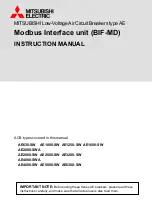
•
MAIN TEN AN CE
MAINTENANCE O F CONTACTS
Rough or high spots should be removed with
a file or emery-cloth. When dressing contacts
be sure to protect the hinged contact of all
poles with a cloth to prevent foreign matter
from lodging in the hinged contact.
CA UTION:
ALL POWER MUST BE REMOVED WHEN
REPLACING, MAINTAINING OR ADJUSTING CONTACTS.
OPERATING MECHANISM
The operating mechanism (Fig. 3) is non
a djustable and consists of a series of non
ferrous links designed to secure low closing
and tripping forces.
To check for friction,
with the breaker open, raise trip finger and
s lowly lower the closing handle.
Release
trip finger and slowly raise handle.
The
l inkage should follow the handle without
sticking and a "click" will be heard just be
f ore the handle reaches the full up position.
To remove the mechanism proceed as follows:
(1)
Remove the breaker cross bar.
(2)
Loosen the outboard bearings at the ends
of the trip bar.
(3) Remove the tension rods between the mech
anism and aluminum panel.
(4) Free the pin
(J-3)* from
the
moving
core.
To free the pin, first remove the cotter pin
from the spacer on the right side of the pin.
Partially close the breaker until the pin
lines up with two holes in the sides of the
mechanism frame.
Hold the moving core up,
and then drive the pin to the right just far
enough to clear the moving core rod.
Lower
the moving core until it hits its stop. Drive
the pin to the left into its original posi
tion.
(5) Remove the four mounting bolts.
a.
CAUTION:
THESE BOLTS ARE ALSO THE MOUNT
ING BOLTS FOR THE CLOSING SOLENOID; THEREFORE,
SUPPORT THE SOLENOID WHILE REMOVING THE BOLTS.
(n)
Remove the Mechanism.
The mechanism is factory
1
ubricated for
life.
CLOSING SOLENOID
The closing solenoid (Fig. 5) is not ad
justable.
To remove the close coil, proceed
as follows:
(I)
CAUTION:
REMOVE THE CLOSE COIL CIRCUIT
VOLTAGE.
(2)
Disconnect the wires from the close coil
terminals.
(3) Loosen the locking clip (4-5) on the bot
tom of the moving core.
(4) Remove bolts (5) , locking clip (4-5) , and
the relay trip bracket (6-5) .
(5) Remove bolts (3-5) , an d using a rawhide
or plastic mallet remove the bottom stationary
core (7- 5) .
(6) Remove the coil.
OVERCURRENT TRIPPING DEVICE
Description
The overcurrent tripping unit for the
DB-75 circuit breaker is an air delayed mag
n eti c type of de vice.
The time- current
characteristics of the trip units are
as
fol
lows:
(1)
Long delay and short delay.
(2)
Long delay and instantaneous.
(3) Instantaneous.
The various ratings of each general type are
o f similar construction and differ only in
springs and calibration.
*The first letter or number refers to the item and the second to the figure number. (Item
J
-
Fig. No. 3) .
1 2
LB. 35-240-1
www
. ElectricalPartManuals
. com










































